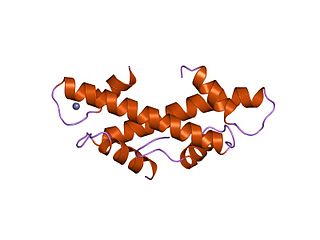Related Research Articles

The preinitiation complex is a complex of approximately 100 proteins that is necessary for the transcription of protein-coding genes in eukaryotes and archaea. The preinitiation complex positions RNA polymerase II at gene transcription start sites, denatures the DNA, and positions the DNA in the RNA polymerase II active site for transcription.

General transcription factors (GTFs), also known as basal transcriptional factors, are a class of protein transcription factors that bind to specific sites (promoter) on DNA to activate transcription of genetic information from DNA to messenger RNA. GTFs, RNA polymerase, and the mediator constitute the basic transcriptional apparatus that first bind to the promoter, then start transcription. GTFs are also intimately involved in the process of gene regulation, and most are required for life.

The TATA-binding protein (TBP) is a general transcription factor that binds specifically to a DNA sequence called the TATA box. This DNA sequence is found about 30 base pairs upstream of the transcription start site in some eukaryotic gene promoters.
Transcription factor II F (TFIIF) is one of several general transcription factors that make up the RNA polymerase II preinitiation complex.

Transcription initiation factor TFIID subunit 7 also known as TAFII55 is a protein that in humans is encoded by the TAF7 gene.

TAF9 RNA polymerase II, TATA box binding protein (TBP)-associated factor, 32kDa, also known as TAF9, is a protein that in humans is encoded by the TAF9 gene.

Transcription initiation factor TFIID subunit 12 is a protein that in humans is encoded by the TAF12 gene.

Transcription initiation factor TFIID subunit 4 is a protein that in humans is encoded by the TAF4 gene.

Transcription initiation factor TFIID subunit 2 is a protein that in humans is encoded by the TAF2 gene.

Transcription initiation factor TFIID subunit 10 is a protein that in humans is encoded by the TAF10 gene.

Transcription initiation factor TFIID subunit 5 is a protein that in humans is encoded by the TAF5 gene.

Transcription initiation factor TFIID subunit 11 also known as TAFII28, is a protein that in humans is encoded by the TAF11 gene.

TATA-binding protein-associated factor 2N is a protein that in humans is encoded by the TAF15 gene.

Transcription initiation factor TFIID subunit 13 is a protein that in humans is encoded by the TAF13 gene.

Transcription initiation factor TFIID subunit 8 is a protein that in humans is encoded by the TAF8 gene.

TAF6-like RNA polymerase II p300/CBP-associated factor-associated factor 65 kDa subunit 6L is an enzyme that in humans is encoded by the TAF6L gene.

Transcription initiation factor IIA subunit 1 is a protein that in humans is encoded by the GTF2A1 gene.

Transcription initiation factor TFIID subunit 9B is a protein that in humans is encoded by the TAF9B gene.
RNA polymerase II holoenzyme is a form of eukaryotic RNA polymerase II that is recruited to the promoters of protein-coding genes in living cells. It consists of RNA polymerase II, a subset of general transcription factors, and regulatory proteins known as SRB proteins.

The TBP-associated factors (TAF) are proteins that associate with the TATA-binding protein in transcription initiation. It is a part of the transcription initiation factor TFIID multimeric protein complex. It also makes up many other factors, including SL1. They mediate the formation of the transcription preinitiation complex, a step preceding transcription of DNA to RNA by RNA polymerase II.
References
- ↑ Høiby T, Zhou H, Mitsiou DJ, Stunnenberg HG (2007). "A facelift for the general transcription factor TFIIA". Biochimica et Biophysica Acta (BBA) - Gene Structure and Expression. 1769 (7–8): 429–36. doi:10.1016/j.bbaexp.2007.04.008. PMID 17560669.
- ↑ Tang H, Sun X, Reinberg D, Ebright RH (February 1996). "Protein-protein interactions in eukaryotic transcription initiation: structure of the preinitiation complex". Proceedings of the National Academy of Sciences of the United States of America. 93 (3): 1119–24. Bibcode:1996PNAS...93.1119T. doi: 10.1073/pnas.93.3.1119 . PMC 40041 . PMID 8577725.
- ↑ Louder RK, He Y, López-Blanco JR, Fang J, Chacón P, Nogales E (March 2016). "Structure of promoter-bound TFIID and model of human pre-initiation complex assembly". Nature. 531 (7596): 604–9. Bibcode:2016Natur.531..604L. doi:10.1038/nature17394. PMC 4856295 . PMID 27007846.
- ↑ DeJong J, Roeder RG (November 1993). "A single cDNA, hTFIIA/alpha, encodes both the p35 and p19 subunits of human TFIIA". Genes & Development. 7 (11): 2220–34. doi: 10.1101/gad.7.11.2220 . PMID 8224848.
- ↑ Ozer J, Moore PA, Bolden AH, Lee A, Rosen CA, Lieberman PM (October 1994). "Molecular cloning of the small (gamma) subunit of human TFIIA reveals functions critical for activated transcription". Genes & Development. 8 (19): 2324–35. doi: 10.1101/gad.8.19.2324 . PMID 7958899.